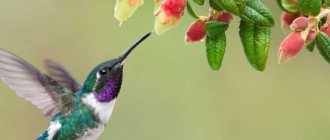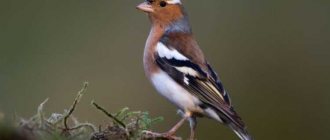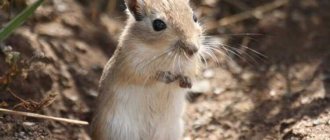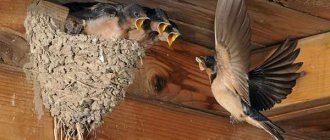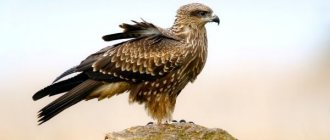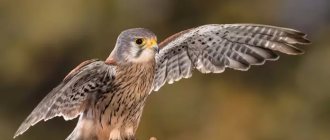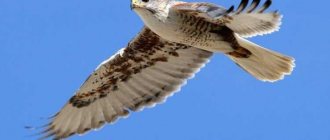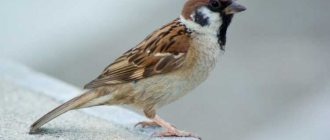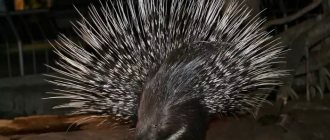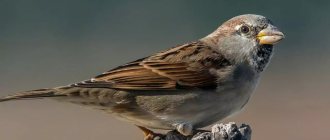Hummingbird
(Trochili) is a suborder of birds of the long-winged order. One family with 319 species. They live in America (from Southern Alaska and Labrador to Tierra del Fuego); are especially diverse in the tropics. Body length is from 5.7 to 21.6 cm, weigh from 1.6 to 20 g. The plumage of males is usually very bright; females are more dull in color.
The flight is fast (up to 80 km/h), maneuverable, reminiscent of the flight of hawk moth butterflies. Small species of hummingbirds make a buzzing sound with their wings in flight, as they make up to 80 beats per second (large ones - only 8-10). Hummingbirds feed on flowers, sucking nectar on the fly, and also collect insects and spiders on plants or catch them in the air. The huge energy consumption for flight and heat transfer is covered by high-calorie food (for example, nectar). Hummingbirds cannot maintain an intensive metabolism around the clock, so at night, in the cold and with a lack of food, they fall into torpor; at the same time, the body temperature drops from 39-43 °C to 14.5-21 °C, and metabolism is sharply reduced.
They live wherever there are flowers: in deserts, gardens, forests, mountain meadows - from sea level to 4500 m (in the Andes). Migratory; They fly away for the winter from the extreme northern and southern parts of their range, and from the deserts during periods of drought. Polygamy; The female builds the nest, incubates the eggs and feeds the chicks. Nests are in trees, bushes; some species stick nests to rocks or leaves with saliva, just like swifts. There are 2 white eggs in the clutch, incubation is 14-19 days. Hummingbirds are useful as plant pollinators. The numbers of many hummingbird species have declined sharply because... They were exterminated in droves, using their skins as decoration.
Hummingbirds feed on nectar
The process of food absorption in these birds occurs directly in flight. Making up to 80-150 wing beats per second, the hummingbird hovers over the calyx of the flower, inserts its sharp beak into it and sucks out tasty and nutritious plant food with the end of its tongue folded into a tube. At the same time, it would be wrong to think that hummingbirds live exclusively on flowers - the main food of hummingbirds (for many species and exclusive) are small insects, which birds collect from flowers and the leaves closest to them. In some cases, hummingbirds are not averse to feasting on captured spiders, as well as insects flying past them.
general description
Hummingbirds are attracted not only by their bright plumage. Their role in nature cannot be overestimated, because many plant species are pollinated exclusively by them. This is especially true for the countries of the New World.
Appearance of hummingbird
The appearance of the bird varies greatly depending on the species. The number of colors and beak shapes cannot be sorted out at one time. Males are often more colorful than females and boast a tuft, elongated tail feathers or other features.
Hummingbirds have a very long tongue, which they move forward at lightning speed to collect nectar. The upper part of the beak seems to cover the lower part. The legs are thin and weak, not adapted to the ground, but they are enough to hold onto branches.
The wings of hummingbirds differ from the wings of other birds, even at the skeletal level. They are more like butterfly wings with developed muscles and a movable shoulder joint. The plumage is characterized by a bright metallic sheen and color changes depending on the angle.
Photo: komotoz.ru
Singing
The sounds of hummingbirds are similar to the birds themselves: fast, sharp, aggressive. Almost all trills are performed at high frequencies, but they can be interrupted by unpleasant guttural sounds. At the same time, the structure of the hummingbird's larynx is the same as that of songbirds, which means that it can learn to sing.
Photo: aikalandros.com
How long do hummingbirds live?
The lifespan of a tiny hummingbird is not so short as for a bird of its size. On average it is 3-5 years, and record figures are 11-12 years. Many species are now listed in the Red Book due to mass fishing and environmental problems. In addition, incubation of hummingbird eggs became at least somewhat possible only 6 years ago.
Photo: m-skazitelnitsa.livejournal.com
Hibernation
Due to the insane speed and rhythm of life, the hummingbird constantly needs feeding. Therefore, chicks while waiting for their mother, and later adult birds during rest, fall into a special hibernation. Their heart rate slows and their body temperature drops below 20 degrees. Night hibernation can only be interrupted by sunrise.
Photo: funart.pro
Flight
Hummingbirds have a unique fluttering flight path, thanks to which they masterfully maneuver and are able to hover in the air. The sharp long wings make very complex figure eights, and the control of the tail allows you to move directly in horizontal and vertical planes. The flapping frequency can reach up to 80 times per second.
Photo: zen.yandex.ru
Records
Hummingbirds have a lot of interesting records. This is the only bird that can fly in the opposite direction. This is one of the smallest vertebrates, but at the same time the most voracious.
The number of heart beats per minute during flight easily exceeds 1200. It is simply impossible to repeat the frequency of its wing flapping without fantastic overheating. Moreover, the volume of the heart is approximately half of the total volume of the hummingbird.
Photo: rhythmofthehome.com
Hummingbirds live only in America
The hummingbird's habitat covers not only the tropical and subtropical zones of America, but also includes the remaining territories of this continent - right up to Alaska. The main conditions for the life of hummingbirds are flowers, and, consequently, forests, mountain meadows and gardens. It is noteworthy that some tropical species of hummingbirds prefer to stay high in the mountains, outside the belt of tree vegetation (for example, the Chimborazo hummingbird (Oreotrochilus chimborazo), a number of species simply take a liking to a specific peak, within which they live.
Where are they found?
These babies seem so fragile and delicate that it is difficult to believe that they are capable of existing anywhere other than a warm tropical climate. However, the species of mountain stars chose to live on the glaciers of the Andes, which are located at an altitude of 5 km. In this area, the weather is almost always cold with high levels of humidity, but brave birds do not leave these regions.
Mountain stars can be found in the glacial zone of the Andes all year round because algae, asters and gentians, which this species is very fond of, are constantly blooming here. In order to survive the night frosts, its representatives hide in the depths of caves. If the weather completely deteriorates, a storm arises or heavy snow falls, then the birds descend a little lower, but as soon as conditions return to normal, they immediately return.
Hummingbirds don't fly like other birds.
Unlike other birds, the baby hummingbird can fly with both its head and tail forward. It won’t be difficult for her to hover in space in one place, take off almost vertically, like a helicopter, and also fall down vertically. This is primarily due to the bird’s highly developed, flexible wings, which actually consist only of feathers and large, strong muscles. The wing of a hummingbird can change the angle of its flapping and move not only up and down, but also back and forth. It is customary to distinguish three types of hummingbird flight: forward flight, backward flight and hovering. In the latter case, the bird's wings describe a figure eight, which allows it to maintain balance regardless of the body's movement in space.
Incredible Heart
To provide such unique abilities, this family has interesting anatomical and physiological features. For example, the heart takes up quite a lot of space in the body of these babies. It is three times larger than the stomach, which is also not very small compared to representatives of other families.
Such a huge size of the heart is due to the fact that during flight it is necessary to move blood very quickly throughout the body. In order for blood circulation to occur as quickly as possible, the heart muscles grow and become powerful, providing high blood pressure. To obtain energy, metabolism also occurs very quickly. In addition, all processes in the body are accelerated and require a large supply of oxygen. To solve this problem, the amount of hemoglobin in the blood is several times increased compared to other birds.
The heart is not just big, it also beats at an incredible speed - 500 beats per second at rest and up to 1000 beats per second during flight. Over the course of a lifetime, about 4.5 billion such beats occur. For comparison, the human heart beats half as much in its entire life.
The life expectancy of these birds is on average 9 years, but rare “long-livers” in conditions of captivity and excellent medical care even reached 17 years.
Tiny sizes
The hummingbird bird has more than 300 species. What makes these birds unique, of course, is their miniature size. Many sources claim that their weight is 20 g. But this is a misconception.
There is a hummingbird - a bee. So she is the smallest. Its weight is 2 g. These crumbs live on the Cube. 7 cm is their maximum size. The largest hummingbird is even larger than a sparrow. So the largest one can grow 22 cm.
Continuation of the family line
The mating season for representatives of this family begins at a time when nature is especially rich in nutrients, which allows them to feed not only themselves, but also their chicks.
The parental mission of males ends exactly at the moment when mating occurs. Then all the care for the offspring is entrusted to the mother: she builds a nest in which children will be born, incubates the eggs and feeds the babies. Most often, the female lays two unusual eggs. They are very small: from a centimeter to two, and their weight is about 0.4 g.
Hatching eggs is a difficult experience for hummingbirds, since 75-90% of the time must be spent in the nest at the expense of feeding. Hatching takes 2-3 weeks. By the time the chicks appear, the mother is quite exhausted.
During the first days, the cubs are very weak, blind and naked, they are not even able to make sounds. But after a month they look formed, feathered and completely ready for independent life.
Enemies
Hummingbirds have few enemies. The baby is very active and maneuverable, so not everyone is able to catch it. In nature, only snakes and tarantulas can feast on it, waiting in dense tropical thickets. Humans hunt for beautiful plumage, causing significant damage to the population of certain species.
Scientists have long been working on the problem of artificial breeding of this rare species of birds. For the first time they managed to achieve positive results in 2015. The resulting hummingbird breeding technology will make it possible to restore many populations of this unusual bird.
Gluttons
Many interesting facts are associated with the nutrition of hummingbirds. These babies love to eat, which is not surprising: to fly with such intensity, they need a huge amount of nutrients. During the day, these birds need a volume of food twice their own weight. This is the only way they can maintain the required level of energy and stable body temperature. Due to high energy costs, overweight birds cannot be in this family even if kept at home with excellent nutrition.
To maintain normal activity, nectar must be supplied every 6-10 minutes, and almost all of their free time these creatures are busy feeding. So that they have the opportunity to sleep peacefully at night and not search for food, nature gave them an original adaptation: during the day the body temperature is very high - 30-40 ° C, but at night these animals fall into a kind of suspended animation with a decrease in body temperature to 18 ° C. At the same time, breathing slows down to the limit.
Under unfavorable conditions, when food is very difficult to find, hummingbirds can fall into this state for a long time. Some ornithologists view this as lethargic sleep. When environmental conditions return to normal, breathing is restored, the temperature rises, and a period of activity begins again.
